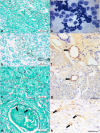Disseminated melanized fungal infection due to Cladosporium halotolerans in a dog coinfected with canine adenovirus-1 and canine parvovirus-2
- PMID: 30997656
- PMCID: PMC6863253
- DOI: 10.1007/s42770-019-00082-6
Disseminated melanized fungal infection due to Cladosporium halotolerans in a dog coinfected with canine adenovirus-1 and canine parvovirus-2
Abstract
This report presents the pathologic findings associated with disseminated infection due to Cladosporium halotolerans in a dog that was simultaneously infected with canine adenovirus-1 (CAdV-1) and canine parvovirus-2 (CPV-2). A 12-year-old, mixed breed dog, with a clinical history of neurological manifestations was submitted for routine autopsy due to poor prognosis. The principal pathologic findings were mycotic necrotizing nephritis, hepatitis, and splenitis with embolic dissemination to the brain resulting in mycotic necrotizing meningoencephalitis, ventriculitis, choroid plexitis, and obstructive hydrocephalus associated with intralesional and intravascular septate pigmented fungi. PCR and sequencing of the ITS region of fungi revealed that the intralesional fungal organisms had 82% nucleotide identity with members of the Cladosporium sphaerospermum complex of organisms. However, a PCR assay and sequencing of the beta tubulin gene confirmed that the organism identified in this dog had 100% nucleotide sequence identity with C. halotolerans. Using immunohistochemistry, intralesional antigens of CAdV-1 were identified within the epithelial cells of the liver and lungs; there was positive immunolabeling for CPV-2 antigens in degenerated cardiomyocytes. These findings confirmed the active participation of C. halotolerans in the development of disseminated cladosporiosis in this dog and represent a rare occurrence of concomitant infection with CAdV-1 and CPV-2.
Keywords: Choroid plexitis; Cladosporiosis; Dematiaceous fungi; Diagnostic pathology; Dog; Pleocytosis; Thromboembolism; Ventriculitis.
Figures





Similar articles
-
Concomitant canine distemper, infectious canine hepatitis, canine parvoviral enteritis, canine infectious tracheobronchitis, and toxoplasmosis in a puppy.J Vet Diagn Invest. 2013 Jan;25(1):129-35. doi: 10.1177/1040638712471344. Epub 2013 Jan 4. J Vet Diagn Invest. 2013. PMID: 23293164
-
Investigation of the presence of canine adenovirus (CAdV) in owned dogs in Northern Italy.Res Vet Sci. 2014 Dec;97(3):631-6. doi: 10.1016/j.rvsc.2014.10.010. Epub 2014 Oct 29. Res Vet Sci. 2014. PMID: 25468801
-
Serological detection of infection with canine distemper virus, canine parvovirus and canine adenovirus in communal dogs from Zimbabwe.J S Afr Vet Assoc. 2014 Sep 5;85(1):1110. doi: 10.4102/jsava.v85i1.1110. J S Afr Vet Assoc. 2014. PMID: 25686382
-
Canine Adenoviruses in Wildlife: Role in At-Risk Species Conservation and Interface with Domestic Animals.Pathogens. 2025 Feb 18;14(2):200. doi: 10.3390/pathogens14020200. Pathogens. 2025. PMID: 40005575 Free PMC article. Review.
-
Cladosporium halotolerans: Exploring an Unheeded Human Pathogen.Mycopathologia. 2023 Dec;188(6):1027-1040. doi: 10.1007/s11046-023-00801-6. Epub 2023 Nov 4. Mycopathologia. 2023. PMID: 37924426
Cited by
-
Recommendations on vaccination for Latin American small animal practitioners: a report of the WSAVA Vaccination Guidelines Group.J Small Anim Pract. 2020 Jun;61(6):E1-E35. doi: 10.1111/jsap.13125. Epub 2020 Mar 30. J Small Anim Pract. 2020. PMID: 32227347 Free PMC article.
-
Canine circovirus and Canine adenovirus type 1 and 2 in dogs with parvoviral enteritis.Vet Res Commun. 2022 Feb;46(1):223-232. doi: 10.1007/s11259-021-09850-y. Epub 2021 Oct 20. Vet Res Commun. 2022. PMID: 34671910 Free PMC article.
-
Difference Analysis Between Canine Adenovirus Types 1 And 2.Front Cell Infect Microbiol. 2022 Mar 11;12:854876. doi: 10.3389/fcimb.2022.854876. eCollection 2022. Front Cell Infect Microbiol. 2022. PMID: 35360116 Free PMC article. Review.
-
Identification of Two Novel Linear Neutralizing Epitopes within the Hexon Protein of Canine Adenovirus Using Monoclonal Antibodies.Vaccines (Basel). 2021 Feb 8;9(2):135. doi: 10.3390/vaccines9020135. Vaccines (Basel). 2021. PMID: 33567652 Free PMC article.
References
Publication types
MeSH terms
Substances
LinkOut - more resources
Full Text Sources
Medical

